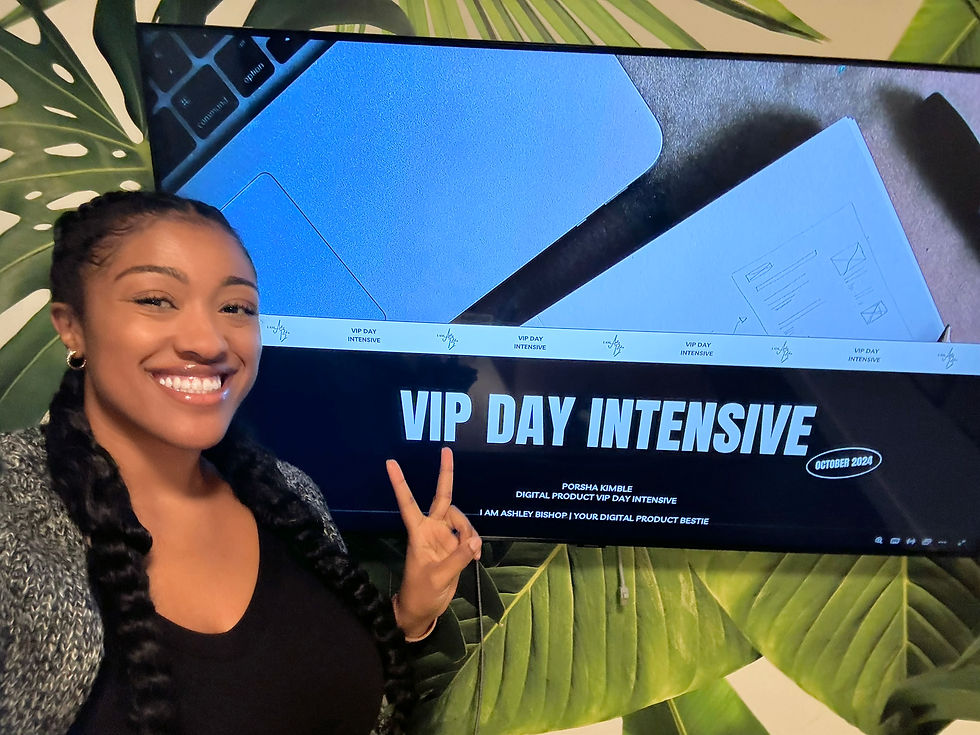DIY Product Photography Tips to Boost Your Website Conversions
- Ashley Bishop

- Dec 4, 2024
- 4 min read
Today, I’m diving into a topic that might seem small but makes a huge difference when it comes to your digital products: DIY Product Photos!
Whether you’re gearing up to launch your first digital product or refreshing an existing one, the quality of your product photos is a major player in the game of website conversions. Amazing images can grab your audience's attention, convey your product’s value, and guide your dream clients from curious browsing to hitting that "Buy Now" button. And let's be real — we all want that, don’t we?
I know not everyone has the budget to work with a professional photographer, but let me tell you, DIY doesn’t have to mean "meh." With the right strategies and a dash of creativity, you can take photos that look professional, elevate your brand, and convert like crazy. Let's get into some of my go-to tips!
Step 1: Set Up the Perfect Background
If you’re looking to showcase your product in its very best light (pun intended!), it all starts with your background. For most product-based images, a solid-colored background is your best friend. A white, cream, or light gray background works wonders for making your product pop. If you want a specific mood or style, you can also try soft pastels or neutral colors that enhance your brand. You don’t need anything fancy — a piece of clean poster board or a smooth bedsheet can work like magic. The goal is to keep things simple so that all the attention goes to your product.
Pro Tip: Avoid cluttered backgrounds and busy patterns! The cleaner and more straightforward the setting, the less your audience gets distracted and the more they focus on your beautiful product.
Step 2: Find Great Lighting (It’s All About That Glow!)
Lighting is the secret sauce of any great photo. Natural light is my top recommendation for DIY photos — it’s free, consistent, and creates a soft, flattering glow. Set up near a window during the day when the light isn’t too harsh (early morning or late afternoon usually works best). If you find shadows are too intense, try diffusing the light with a sheer curtain or a piece of white fabric. This will help keep everything looking soft and professional.
If you need a bit more control or are shooting in a space without much sunlight, you can always invest in an affordable ring light or softbox light. These lights can make your DIY setup look extra polished, and they’re surprisingly easy to use.
Pro Tip: Avoid using direct overhead lights or fluorescent bulbs. They tend to cast unflattering shadows and can make colors look less accurate. Always aim for soft, even lighting that highlights your product's best features.
Step 3: Style It Up!
Your product is the star of the show, but a few thoughtfully chosen props can add context, warmth, and help your customers envision themselves using your product. Keep your styling minimal and make sure that every element in your shot supports your brand story. If you’re showcasing a digital planner, maybe add a cute pen and a cozy coffee cup. If it’s a beauty product, try using complementary items like a soft towel or a sprig of eucalyptus for that extra touch.
Just remember: less is more. You want your props to frame your product, not overpower it. Avoid using props with busy patterns or too many colors, as they can distract from your product.
Step 4: Shoot from Multiple Angles
Your customers want to understand what they’re buying, and the more angles you show, the more confident they’ll feel. Take a variety of shots: front, back, close-ups, and different perspectives. Detail shots are also super important, especially if your product has a unique feature or texture that you want to highlight. Try to capture how your product looks in action — that’s especially effective for conveying usability.
Pro Tip: Consistency is key here too. Make sure you’re using the same lighting and background for all your shots to create a cohesive and professional look.
Step 5: Edit (But Keep It Real!)
After you’ve taken your photos, it’s time to give them a bit of a polish. You don’t need any fancy software; tools like Canva or Lightroom Mobile are perfect for editing photos on a budget. Adjust the brightness, contrast, and sharpness, but avoid going overboard with filters. You want your product to look as true to life as possible while also being eye-catching.
Pro Tip: Keep your editing simple. Consistency is crucial, so make sure all your photos have a similar style and color tone, which will make your website look cohesive and professional. Avoid heavy filters or unnatural edits that could make your product look different from reality — your customers want to see the real deal.
Remember, A Pro Is Always Worth It
I’ll be the first to say that if it’s in the budget, hiring a professional photographer is always worth the investment. They bring years of expertise in composition, lighting, and styling that can take your product photos to a whole new level. But until then, these DIY tips will absolutely do the trick and help you create scroll-stopping images that boost conversions.
I hope this helps you feel more confident about capturing those amazing shots of your products. Remember, your website visitors can't touch or feel your products, so the photos you take are doing all the talking. Make them shine!
If you’re ready to level up your digital product strategy (photos included) and want a partner in the process, you know I’m your digital product bestie. Feel free to reach out, and let’s create magic together!
Until next time, Ash (Your Digital Product Bestie!)




Comments